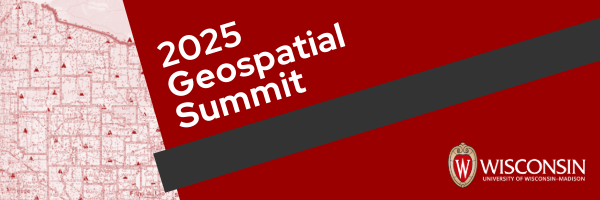The 2025 Geospatial Summit will be held on Wednesday, April 16, 2025, in the Gordon Event Center, 770 W Dayton St, Madison.
The Summit is an annual event sharing geospatial research and program updates, employment and internship opportunities, and new ideas and initiatives.
Summit attendees include students, staff and faculty at UW–Madison and other Universities of Wisconsin campuses, staff from government agencies at all levels, representatives from the private sector and non-profits, and the general public.
The Summit is free and open to all.
Agenda
10 a.m. – Keynote Address by David Hart: Three Decades of Coastal GIS at Wisconsin Sea Grant
Brief Description: Many of the issues associated with managing Great Lakes resources are unique, complex and challenging. You can approach them from multiple, and often competing, perspectives. Conditions change frequently and solutions are hard to test. Adaptive management of Great Lakes resources involves applying a structured, iterative process of decision-making under high levels of uncertainty. It allows incremental actions to be taken while continually collecting more information to reduce uncertainty and refine management. Effective practice of adaptive management benefits from the discovery, acquisition, integration, analysis and visualization of multiple sources and formats of geospatial data. Since 1994, Wisconsin Sea Grant has collaborated with many partners to apply geospatial technologies to explore and analyze the issues facing the Great Lakes. This presentation shares the lessons learned from three decades of coastal GIS in Wisconsin, describes current Wisconsin Sea Grant GIS collaborations and looks to the future of geospatial technologies for adaptive management of coastal resources.
David is a Senior Scientist with the University of Wisconsin Aquatic Sciences Center and serves as the Associate Director for Extension at the University of Wisconsin Sea Grant Institute.
11:15 a.m. – Janet Silbernagel from Silvernail Geodesign and Ben Yahr from Resolution Studio, LLC: Beyond the Dashboard: Using ArcGIS tools for Fieldwork, Resilience Planning, and Public Outreach
We are a collaborative team of landscape architects/UAV pilot and geodesigner, using interactive map tools to support field monitoring and collaborative decision-making in large, complex projects, and to help communicate their story to broader audiences. Together we developed integrated ArcGIS tool suites for two Milwaukee area projects. The first was for the riparian restoration and monitoring of the Kinnickinnic River through Pulaski Park. We will describe how our initial vision for a Story Map as a living deliverable grew to include Field Maps for bi-annual checks on woody vegetation and a whole Collection of apps to track and communicate the progress of restoration. Then we will illustrate a working project for Milwaukee County Parks to assess bluff resilience and prioritize mitigation projects at 13 parks along the Lake Michigan shoreline. Here we designed a collaborative communication tool with Experience Builder that hosts several embedded Story Maps, web maps and apps, and a project ranking dashboard.
Janet is the founder and sole proprietor of Silvernail Studio for Geodesign, LLC.
Ben is founder of Resolution Studio, LLC.
12 p.m. – Christian Andresen from the UW–Madison Geography Department: Examining the Role of Vegetation on Coastal Bluff Stability Using Drone LIDAR
Brief Description: Coastal erosion and the permanent loss of land and infrastructure has been an ongoing challenge along the bluffs of Ozaukee County. Past and ongoing efforts to monitor bluff stability using drones have focused on bare, non-vegetated bluff surfaces given the limitation of photogrammetric methods to capture the bluff surface under vegetation. The lack of understanding of bluff stability processes in vegetated areas is of concern given the large portion of vegetated bluffs across Ozaukee County and Wisconsin. Recent technological advancements have allowed the development of drone-based LIDAR which captures ground surface properties including areas with thick vegetation, providing an untapped technology for assessing bluff stability. In addition, drone LIDAR also captures the 3D structural arrangement of vegetation (e.g. height, density, etc) which allows us to quantify the role of vegetation structure on bluff failures. This study will provide a well-constrained quantitative assessment on the rates of bluff destabilization in both vegetated and non-vegetated surfaces while characterizing the structural properties of bluff vegetation and its effects on erosion rates in Ozaukee County.
Christian is an Assistant Professor in the Geography Department.
1:30 p.m. – The career panel will feature Jay Riester from Seiler Geospatial; Zachary Nienow from Ayres Associates Inc.; Tomissa Freisleben from Cyclomedia; and Janet Silbernagel from Silvernail Geodesign
2:30 p.m. – Career fair with representatives from local GIS companies and agencies, including: Ayers Associates, Silvernail Studio for Geodesign, Seiler Geospatial; Cyclomedia; Capital Area Regional Planning Commission; the Nelson Institute; SAGIC; NV5; US Physical Plant; Cloudpoint; Wisconsin Land Information Association; State Cartographer’s Office; and more.
More information is available here.
To help with planning, please register for the Summit here.

